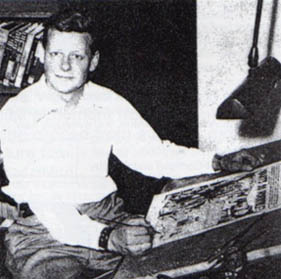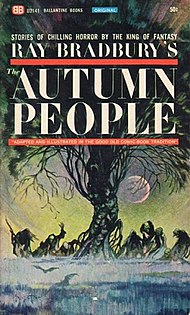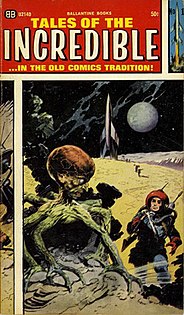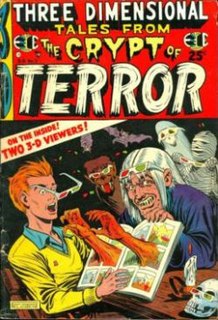Entertaining Comics, more commonly known as EC Comics, was an American publisher of comic books, which specialized in horror fiction, crime fiction, satire, military fiction, dark fantasy, and science fiction from the 1940s through the mid-1950s, notably the Tales from the Crypt series. Initially, EC was owned by Maxwell Gaines and specialized in educational and child-oriented stories. After Max Gaines' death in a boating accident in 1947, his son William Gaines took over the company and began to print more mature stories, delving into genres of horror, war, fantasy, science-fiction, adventure, and others. Noted for their high quality and shock endings, these stories were also unique in their socially conscious, progressive themes that anticipated the Civil Rights Movement and dawn of 1960s counterculture. In 1954–55, censorship pressures prompted it to concentrate on the humor magazine Mad, leading to the company's greatest and most enduring success. Consequently, by 1956, the company ceased publishing all of its comic lines except Mad.

Gemstone Publishing is an American company that publishes comic book price guides. The company was formed by Diamond Comic Distributors President and Chief Executive Officer Steve Geppi in 1994 when he bought Overstreet.

Tales from the Crypt is a 1972 British horror film directed by Freddie Francis. It is an anthology film consisting of five separate segments, based on stories from EC Comics. It was produced by Amicus Productions and filmed at Shepperton Studios, and is one of several Amicus horror anthologies made during the 1970s.

Graham J. Ingels was a comic book and magazine illustrator best known for his work in EC Comics during the 1950s, notably on The Haunt of Fear and Tales from the Crypt, horror titles written and edited by Al Feldstein, and The Vault of Horror, written and edited by Feldstein and Johnny Craig. Ingels' flair for horror led EC to promote him as Ghastly Graham Ingels, and he began signing his work "Ghastly" in 1952.

The Vault of Horror was an American bi-monthly horror comic anthology series published by EC Comics in the early 1950s. Along with Tales from the Crypt and The Haunt of Fear, it formed a trifecta of popular EC horror anthologies. The Vault of Horror hit newsstands with its April/May 1950 issue and ceased publication with its December/January 1955 issue, producing a total of 29 issues.

The Haunt of Fear was an American bi-monthly horror comic anthology series published by EC Comics, starting in 1950. Along with Tales from the Crypt and The Vault of Horror, it formed a trifecta of popular EC horror anthologies. The Haunt of Fear was sold at newsstands beginning with its May/June 1950 issue. It ceased publication with its November/December 1954 issue, compiling a total of 28 issues.

Crime SuspenStories was a bi-monthly anthology crime comic published by EC Comics in the early 1950s. The title first arrived on newsstands with its October/November 1950 issue and ceased publication with its February/March 1955 issue, producing a total of 27 issues. Years after its demise, the title was reprinted in its entirety, and four stories were adapted for television in the HBO's Tales From The Crypt.

Tales from the Crypt was an American bi-monthly horror comic anthology series published by EC Comics from 1950 to 1955, producing 27 issues. Along with its sister titles, The Haunt of Fear and The Vault of Horror, Tales from the Crypt was popular, but in the late 1940s and early 1950s comic books came under attack from parents, clergymen, schoolteachers and others who believed the books contributed to illiteracy and juvenile delinquency. In April and June 1954, highly publicized congressional subcommittee hearings on the effects of comic books upon children left the industry shaken. With the subsequent imposition of a highly restrictive Comics Code, EC Comics publisher Bill Gaines cancelled Tales from the Crypt and its two companion horror titles, along with the company's remaining crime and science fiction series in September 1954. All EC titles have been reprinted at various times since their demise, and stories from the horror series have been adapted for television and film.

Shock SuspenStories was part of the EC Comics line in the early 1950s. The bi-monthly comic, published by Bill Gaines and edited by Al Feldstein, began with issue 1 in February/March 1952. Over a four-year span, it ran for 18 issues, ending with the December/January 1955 issue.

Weird Fantasy is a dark fantasy and science fiction anthology comic that was part of the EC Comics line in the early 1950s. The companion comic for Weird Fantasy was Weird Science. Over a four-year span, Weird Fantasy ran for 22 issues, ending with the November–December 1953 issue.

John Thomas Alexis Craig, was an American comic book artist notable for his work with the EC Comics line of the 1950s. He sometimes used the pseudonyms Jay Taycee and F. C. Aljohn.

The Autumn People is a mass-market paperback collection of comic adaptations of eight short horror and crime stories by Ray Bradbury, gathered from the pages of the EC Comics comic books of the 1950s. It is one of five EC collections published by Ballantine Books between 1964 and 1966, and one of two made up of comic adaptations of Bradbury's work. The presentation of the material is problematic at best, since the color comic book pages are represented in black and white and broken into horizontal strips to fit the mass-market paperback format. Still, the collections are historically important. They were the first attempt to resurrect the EC comics, only a decade after public outcry had driven them off the racks. They were the first introduction of those comics to a generation of readers too young to remember them in their first run.

Tomorrow Midnight is a mass-market paperback collection of comic adaptations of eight short science fiction stories by Ray Bradbury, gathered from the pages of the EC Comics comic books of the 1950s. It is one of five EC collections published by Ballantine Books between 1964 and 1966, and one of two made up of comic adaptations of Bradbury's work. The presentation of the material is problematic at best, since the color comic book pages are represented in black and white and broken into horizontal strips to fit the mass-market paperback format. Still, the collections are historically important. They were the first attempt to resurrect the EC comics, only a decade after public outcry had driven them off the racks. They were the first introduction of those comics to a generation of readers too young to remember them in their first run.

The EC Archives are an ongoing series of American hardcover collections of full-color comic book reprints of EC Comics, published by Russ Cochran and Gemstone Publishing from 2006 to 2008, and then continued by Cochran and Grant Geissman's GC imprint (2011–2012), and finally taken over by Dark Horse in 2013.

Horror comics are comic books, graphic novels, black-and-white comics magazines, and manga focusing on horror fiction. In the US market, horror comic books reached a peak in the late 1940s through the mid-1950s, when concern over content and the imposition of the self-censorship Comics Code Authority contributed to the demise of many titles and the toning down of others. Black-and-white horror-comics magazines, which did not fall under the Code, flourished from the mid-1960s through the early 1980s from a variety of publishers. Mainstream American color comic books experienced a horror resurgence in the 1970s, following a loosening of the Code. While the genre has had greater and lesser periods of popularity, it occupies a firm niche in comics as of the 2010s.
Russ Cochran was a publisher of EC Comics reprints, Disney comics and books on Hopalong Cassidy, Chet Atkins, Les Paul and vacuum tubes. He has been a publisher for over 30 years, after quitting his job as a physics professor.

Tales of the Incredible is a mass-market paperback collection of eight science fiction comic stories gathered from the pages of the EC Comics comic books of the 1950s. It is one of five collections published by Ballantine Books between 1964 and 1966. The presentation of the material is problematic at best, since the color comic book pages are represented in black and white and broken into horizontal strips to fit the mass-market paperback format. Still, the collections are historically important. They were the first attempt to resurrect the EC comics, only a decade after public outcry had driven them off the racks. They were the first introduction of those comics to a generation of readers too young to remember them in their first run.

Tales from the Crypt is a mass-market paperback collection of eight horror comic stories gathered from the pages of the EC Comics comic books of the 1950s. It is one of five such collections published by Ballantine Books between 1964 and 1966. The presentation of the material is problematic at best, since the color comic book pages are represented in black and white and broken into horizontal strips to fit the mass-market paperback format. Still, the collections are historically important. They were the first attempt to resurrect the EC comics, only a decade after public outcry had driven them off the racks. They were the first introduction of those comics to a generation of readers too young to remember them in their first run.

Three Dimensional E.C. Classics was a quarterly comic book anthology series published by EC Comics in 1954. It began publication with its Spring 1954 issue and ceased with its March 1954 issue, producing a total of two issues. The stories it contained were classics in that they were recyclings of stories that had already appeared in earlier EC comic books. However, all new artwork was done for these books, rather than applying the 3-D process to the original illustrations from the first presentations of the stories. They were three-dimensional because they were presented in Anaglyph 3-D. Two 3-D viewers were included with each issue.
















